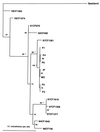Nosocomial transmission of echovirus 30: molecular evidence by phylogenetic analysis of the VP1 encoding sequence
- PMID: 10921945
- PMCID: PMC87138
- DOI: 10.1128/JCM.38.8.2889-2892.2000
Nosocomial transmission of echovirus 30: molecular evidence by phylogenetic analysis of the VP1 encoding sequence
Abstract
We investigated six cases of enterovirus infection in a neonatal unit. The index patient, a 5-day-old boy, was admitted with aseptic meningitis due to echovirus 30 (E30). Secondary infections with E30 occurred in five babies. Comparison of the complete VP1 sequences showed that the isolates recovered from the index patient and his mother were closely related to those recovered from the five babies with secondary infections, demonstrating a nosocomial transmission of the virus. In the phylogenetic tree reconstructed from the VP1 sequences, the isolates formed a monophyletic cluster related to an E30 strain collected in June 1997 during an outbreak of aseptic meningitis.
Figures

References
-
- Abzug M J. Perinatal enterovirus infections. In: Rotbart H A, editor. Human enterovirus infections. Washington, D.C.: ASM Press; 1995. pp. 221–238.
-
- Aymard M, Chomel J-J, Lina B, Thouvenot D. Annual report 1997. Lyon, France: National Reference Center for Enteroviruses and Hepatitis A; 1997.
-
- Bailly J-L, Borman A M, Peigue-Lafeuille H, Kean K M. Natural isolates of echovirus type 25 with extensive variations in IRES sequences and different translational efficiencies. Virology. 1996;215:83–96. - PubMed
Publication types
MeSH terms
Associated data
- Actions
- Actions
- Actions
- Actions
- Actions
- Actions
- Actions
- Actions
- Actions
- Actions
- Actions
- Actions
- Actions
- Actions
- Actions
- Actions
- Actions
- Actions
- Actions
- Actions
- Actions
LinkOut - more resources
Full Text Sources

